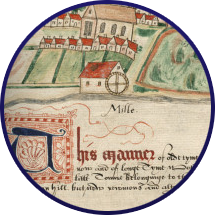Everyday Life in a Northumbrian Manor

Manorial FAQs
Find the answers to some FAQs about manors and manorial documents. Click on the question box to expand.
A manor was an area of land with the Lord (or Lady) of the Manor at its head. A manor differed from an estate in that the Lord (or Lady) of the Manor had a right to hold a manor court. The manor courts heard cases regarding land transfer and failure to uphold the laws (customs) of the manor. Records created by the manor can be extremely important telling the stories of a local community and the people of the community. References are made to people of varying social status and it may be possible to find reference to women amongst the records.
The Manorial Documents Register, sometimes known as the MDR, is an electronic finding aid located on the website of The National Archives – Manorial Documents Register (nationalarchives.gov.uk). The Register records all known manorial records for all English and Welsh counties. This includes records in private hands as well as those held publicly. Recording the existence of manorial records is a legal requirement that came into being when the Law of Property Act was passed in 1922. Legally, the existence of the most important classes of manorial records – ‘court rolls, surveys, maps, terriers, documents and books of every description relating to the boundaries, franchises, wastes, customs or courts of a manor’– must be recorded in the Manorial Documents Register. The Register provides a list of surviving documents by manor with covering dates. It does not include images or transcripts of documents. It’s value to a researcher is therefore to allow the location of surviving records.
Records do not survive for all manors. As part of the Northumberland revision of the Manorial Documents Register we were able to prove the existence of a large number of manors for which no records are known to survive. As part of the revision we prepared Manor History files for all proven Northumberland manors and we hope eventually to place all of these files on our webpages.
The main record of the manor was the court roll. These were effectively the minutes of the court, recording the names of the jurors, the cases heard at the court and the outcome of each case. Manorial surveys, maps and terriers detail the land/property that formed the manor. Surveys sometimes record the names of tenants. Jury lists record all manorial tenants eligible to serve on the jury. Call rolls, sometimes known as suit rolls, record the names of those attending each court. The majority of manorial property was held by a form of tenure known as copyhold. Copyhold transactions are recorded in the court rolls and in a series of documents known as surrenders and admissions. More detail about the kind of documents to be found in manorial collections can be found in our online talk – link to the talk can be found here – What are Manorial Documents – Northumberland Archives. Looking at the sample documents that we place on these webpages will help you understand the different documents and how they can be used.
About 41% of surviving Northumberland manorial records are held by Northumberland Archives with a further 41% held by Northumberland Estates. The remaining 18% are largely held by The National Archives and other Local Authority Archives. The Manorial Documents Register notes the location of all of the records listed.
The main type of information that manorial records provide relates to crime, families, individuals, inheritance, land holdings and land use, local laws or customs, legal history, local trade, manorial courts and how they worked and markets. Generally, records can be used to support family history, property history and the history of communities.
The earliest Northumberland manorial record that we have been able to locate is dated 1278. This is a court roll for the Manor of Black Callerton and is held by Northumberland Archives. Many early manorial records have not survived but there is a quantity of records that pre-date the introduction of parish registers in the 16th century. You might expect to find manorial records existing until the 1920s. The Law of Property Act of 1922 ended copyhold tenure, one of the key features of manorial law, thereby effectively ending manorial system.
Very few manorial records are available online. Prior to this project none of the Northumberland manorial records were available online. The aim of our project is to increase usage of manorial collections by explaining what kind of information they contain and how to understand them. As part of this process, we are digitising and transcribing some of the records.
Later records are written in English but prior to 1734 you are likely to find that at least some part of the record is written in Latin. The documents tend to be formulaic and it is relatively easy to learn the Latin words and phrases used in manorial documents.
Prior to this project we were unaware of the existence of transcripts of any Northumberland manorial records. One of the aims of the project is to make some of the manorial records in our care available as digital copies with transcripts. It is not possible to transcribe all manorial records in our care but we hope that this project will encourage more researchers to look at original manorial records. We will be adding more images and transcripts to the webpages as the project progresses.
If it isn’t obvious which manor a place formed a part of you should check a county directory such as Kelly’s Directories. This may tell you which manor a place formed a part of and the name of the Lord of the Manor. Some directories are available online at Historical directories | Archives and Special Collections | University of Leicester and also via commercial websites such as Ancestry and FindMyPast. Archives and Local Studies collections usually hold a good selection of local directories.
Some manorial collections include maps that set out the boundaries of the manor. These can be helpful in discovering which places formed part of that manor.
Manorial records do contain words that a researcher may not recognise. You should use the glossary on our webpage to help you understand these terms. We will be adding to the glossary as the project progresses.

